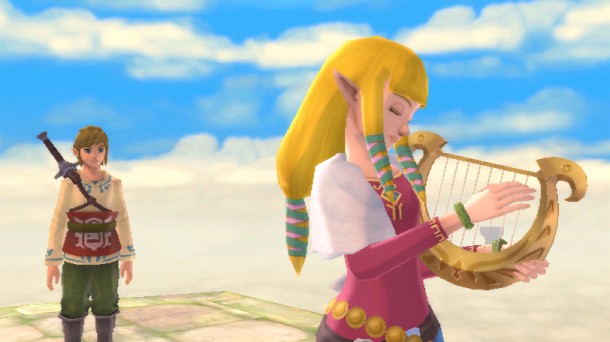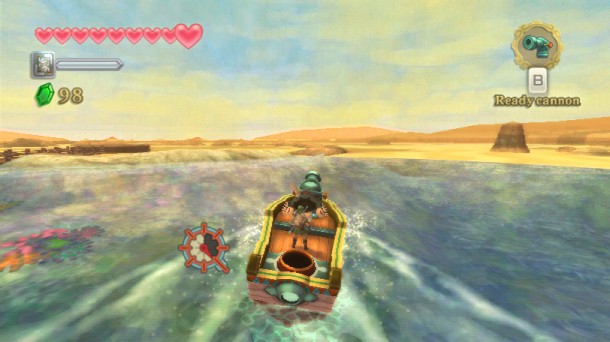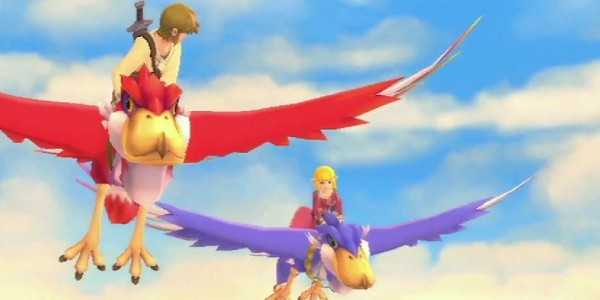Whenever the offer to review a Legend of Zelda game comes over to me, I normally pass on it. After all, why would someone like me who has never played one of the series’ games through to completion, let alone enjoyed much of it, review the newest iteration? Nintendo has kept the series around for more than two decades and I’ve only dabbled in a few of the games since its debut on the NES, never finding the lust that so many have for them. But instead I decided to volunteer for the endeavor. This may be partly because my Wii hasn’t been used for anything but family Wii Sports outings for years and I was looking to dust if off, and partly because I realized that I needed to spend some real amount of time with Link on his journey to reunite with Zelda.
It’s my job to be knowledgeable about the gaming industry, and because of it I know how a Zelda game generally goes down. A green-suited boy named Link will travel far too long of a way through various lands, taking the time to help others along the way, eventually ending up in a dungeon full of enemies to fight a boss, collecting integral tools within. All of this is to save Princess Zelda, because she’s always needed elsewhere. At this point even I feel tired of the formula.

The Legend of Zelda: Skyward Sword bleeds similarity and simultaneously forces its uniqueness down your throat, mostly because it has to. Waggling is for the lazy now; Link’s sword is an extension of your wrist, moving as you do. Thankfully taking the net away on motion control for the primary tool works more often than not, as it is a mechanic that could have broken the entire game. For the few times it doesn’t work, I would fall out of the game’s trance and feel like an idiot jabbing at the television again. The on and off nature of success is a hard one to forgive because the confidence and precision it evokes when pulled off is extremely addicting. At times, the innate disgust for motion control I’ve had in the past few years would disappear. While it was exhilarating to perform, I still feel like I’m praising something that should have happened three years ago.
It should be no surprise that the rest of the game largely hasn’t changed, especially for someone who is luke-warm on everything Zelda. Nearly dragging on for too long, the intro builds Link and Zelda’s relationship up to rip it in half. At a singular moment in particular before their separation, the two share gazes while the rest of the world comes to a halt; it was far more touching than anything I’ve seen in a Zelda game before and it leaves at the very second I wanted more. Games struggle to portray emotion without feeling overt, and it’s brief scenes like this one that remind me that few people out there understand it. Amongst the lull of exposition that saturates the first few hours of the game though, everything else becomes a blur.

Shortly after this scene Link’s assistant Fi — who turns out to be more “sentence-repeating-parrot-on-the-shoulder” than useful in most cases — is introduced. She lives in Link’s new sword and provides the dowsing ability, essentially a mindless way to point us in the right direction towards the next objective; it’s a tool that undoubtedly feels contrived. Maybe it was her constant reiteration of everything obvious or her inability to quell my frustration during the lack of direction in a puzzle, but this caused her presence to be more tedious than welcome.
Once portals are opened to the surface from Link’s home in the sky, aptly named Skyloft, the majority of Skyward Sword’s predictability begins. Each world consists of a theme, whether it’s a lush forest or an arid volcano, and the hazards and usual set of enemies are altered to fit. A short time is spent becoming accustomed to each environment’s inhabitants, usually in need of some kind of help before disclosing the location of where Zelda might be. The first time through the three main locations many things will not be accessible until further in the game when Link holds the right equipment. Eventually, someone will let you know where you’re headed and the core of the Zelda series will begin.
Complexity in seemingly simple environments is the key draw for Skyward Sword’s dungeons. Often rooms are discovered that you would have otherwise assumed nonexistent. Most of the solutions are replications of previous tasks, but sometimes they are completely new ideas that take some thinking and sometimes outright guessing to succeed at. Skyward Sword refuses to communicate its limits, instead leaving them for you to discover. Failing to play by Zelda’s rules of logic can result in frustrating scavenger hunts for a clue about what to do next. Sometimes it’s as simple as missing the crack on the wall, but other times it’s not knowing a certain action was possible. If you are familiar with Zelda’s tricks you may not have a problem, newcomers will probably find it irritating.

Somewhat obviously the enemies we encounter conform to Link’s directional slashes. A three-headed beast will position its heads in diagonals for us to slash in one slice, and failing to remove all three will result in the rebirth of the dismembered ones. Most every enemy has a tell that you must act upon with a swipe of the sword in the appropriate direction. The normal fodder enemies appear along with a few stronger variants, but it’s nothing too daunting. After the first boss battle, one that very blatantly teaches you to use patience before attacking, the rest had varying degrees of challenge and learning. When the attackers start to require successive directional slashes, the dial between frustration and nimble engagement tends to slide to the latter side, but the threat of it bouncing back is always there.
Link’s repertoire of tools expands with each dungeon; many familiar Zelda stapels return with a few new additions. Holding down the B button brings up Link’s selection of gadgets on a wheel, and flinging the Wii remote in the direction of a desired instrument is surprisingly quick and efficient during hectic situations. As soon as a dungeon’s signature tool is introduced everything seems to “click”, revealing unnoticed areas that were previously rushed through during the initial exploration. Upon exiting the dungeon we are left feeling like masters of its terrain, something many other games gloss over with shiny rewards instead. The first time is invigorating, and it only gets stronger after the next two. But, not long after, whiffs of noticeable repetition begin to deteriorate the subsequent experiences.
An upgrade system is present in Skyward Sword that appears to be almost forcefully implemented out of desperation for a new bullet point. Chests, enemies, and sometimes grass will hold various items that can be used to upgrade Link’s arsenal. None of them are necessary, but some of them will help. For example: upgrading the slingshot will cause it to shoot more Deku seeds at a time — again, not anything vital. This feature is somewhat ruined by having to run around a la classic grinding to collect the materials. Each time an area is entered all of the items will act as if they have never been seen before, exposing the useless description text for the first of every one picked up. This is one of those mechanics that holds potential for a second try in the future.
Diverging from the main story line will grant the option to run errands for townsfolk. Most of the side quests are just that, fetch quests, and as a result are not much fun. Surprisingly a lot do exist, making it fairly easy to bump up your play time by many hours. I found myself leaning towards saving the world instead of helping the citizens with their menial problems.

Did I mention that Skyward Sword is a beautiful game? It’s also stricken with jagged edges and fuzzy textures on a high-definition television. But hardware aside, the art style is a mix of watercolor and realistic effects. Everything is bright like Wind Waker but grounded in reality as Twilight Princess was. Over time during lengthy play sessions, the limitations of the Wii’s ability to represent the visuals pleasingly fade away.
One of the most interesting things about Skyward Sword that has to be pointed out to me pertains to the music, referring specifically to the shop keepers. Nearing each clerk the soundtrack will dynamically change depending on who is nearest you. Staring at the gruff-looking repair man, metal clinks and other whimsical hardware store noises scatter in between the notes of the base theme; it’s a wonderfully delightful effect. Of course the rest of the music is good too, but nothing sounds especially outstanding during the action; it’s the still moments that stick out.
Signed and completed, the checklist for Skyward Sword reads that it’s a Zelda game. The pact it makes with motion controls is a brave one, and luckily it avoids the pitfalls so many others have fallen down. But just because it does something new and stays within the confines of Zelda design does not allow it to rely on nostalgia for easy praise, because in my case, and presumably many newer generations, we have none. Even so, the amount of confidence it places in us to trustfully take its hand, showing what it has to offer, is at times dumbfounding. Games don’t take commitment as seriously as Zelda when it comes to tradition, but it’s that very thing that I can’t seem to find appealing. Unfortunately, the usual routine drags down to a chore after the first few dungeons, strapping the interest to keep playing on the narrative and puzzles which offer little to allure. We have to want to play Zelda again, not for the first time. Because of Skyward Sword I know that motion controls, if fully committed to, can work, but also because of Skyward Sword I know that Zelda games will never change, having no problem with leaving people like me behind.
This review is based on a copy of the game purchased by SideQuesting.


1 Comment